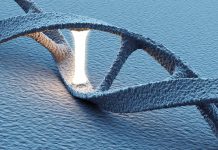Fossil layers seem to be consistent with some independent phylogenetic analyses, radiometric dating methods seem to be consistent with inferences based on the DNA “molecular clock,” continental drift over millions of years seems to be consistent with the distribution of species and fossils on Earth… and the examples go on. If the evolution of life is not a real phenomenon, how can we have this apparent consensus between several independent strands of scientific research?
The theory of evolution by natural selection presupposes a naturalistic process whose probabilities of origin (abiogenesis) and evolution (complexification of genetic information under selective pressure) are so astronomically infinitesimal as to be unworthy of consideration. This is the strongest argument that can be made against the naturalistic theory of evolution: it is even “theoretically” untenable from a probabilistic point of view, regardless of the strength or weakness of the empirical evidence presented.
The strongest argument
Yet today, when we know more than ever about the astonishing functional complexity of life, the scientific world is more convinced than ever of the “naturalism” of its origin and development.
In the mid-19th century, knowledge of biology was very limited compared to today. For example, the cell was seen as a mere building block of life, without much internal structure. Even so, when Charles Darwin proposed the theory of evolution by natural selection, it met with fierce opposition, partly because scientists distrusted the power of chance (guided by natural selection) to produce the biological complexity they knew at the time. Today we know immeasurably more about biology in general, and cell and molecular biology in particular. And the more we know, the more complex, not simpler, life becomes. Paradoxically, however, scientists have almost completely abandoned their initial doubts about the power of naturalistic evolution, and this is arguably one of the greatest triumphs of evolutionary theory to date.
Of course, this state of affairs has also been brought about by the apparent and numerous timely confirmations of the theory, the scientific effort invested in developing the theory, and the consistent effort to interpret reality through an evolutionary lens. However, there can also be timely criticisms that cannot be ignored, as we have shown in this series of articles.
But what seems to have decisively overcome the doubts is another element that cannot be underestimated in terms of its persuasive power: the theory of evolution seems to be supported by evidence from diverse and independent scientific fields. Today, a growing number of scientific fields, from molecular biology and genetics to ecology, from geology to archaeology, from the social sciences to cosmology, all seem to provide evidence that directly or indirectly confirms the principles of evolution in nature. Just as probabilities might be the strongest argument against evolution, this apparent convergence of evidence is the strongest argument for evolution. In this final article, we will look at some of the arguments that support this strongest case for evolution.
Evolution: real issues
First, let’s return to some of the issues we’ve looked at so far in this series on genetics and evolution:
Non-functional DNA. The human body is made up of over 37 trillion of its own tightly coordinated cells, and the blueprint for the development, make-up, and functioning of this gigantic biomolecular machinery is stored almost entirely in the over six billion “letters” (base 4) of human nuclear DNA. If we were to convert this amount of information into the binary code of computers, we would get about 760 megabytes, roughly the capacity of a digital CD.
The theory of evolution requires that large areas of the genome are without function, serving as a “workshop of chance.” And indeed, it is argued that about 96% of the human genome is functionless (a generally valid claim, not just for the human genome). This would mean that only about 30 megabytes of information would really matter in the blueprint of a human’s make-up. But from a purely computational point of view, “encoding” the information of an organism as complex as a human being with only 760 megabytes is already a very difficult task. To do so with only 30 megabytes is almost unbelievable, although the analytical tools to rigorously demonstrate this intuitive fact are still lacking. But perhaps less questionable is the fact that a recent and respected large-scale scientific project, ENCODE[1], has found that over 80% of what is considered non-functional in the human genome actually has various active biochemical functions and is involved in various ways in the functioning of the body.
Population genetics. The part of a species’ genome that is considered non-functional (over 95%, as mentioned above) cannot evolve by natural selection, because something that has no function cannot be under positive or negative selection. For this reason, another process called “genetic drift” is thought to be responsible for the evolution of this quantitatively most important part of the genome. However, genetic drift is, by definition, based only on mathematical modelling of the risk of a mutation spreading, so the legitimate question arises: How is the genome of a species coherent and common to all individuals in its non-functional part, not just in its functional part? The long period of evolution should have accumulated countless divergent mutations between members of the species in an area of the genome that is supposed to have no function. And we’re not talking about a tiny part of the genome, but over 95% of the genome.
Methodologies for comparing species. Evolutionary theory generally interprets similarity as being due to common ancestry, be it genetic, morphological or even behavioural similarity. This interpretation is in no way dictated by the evidence, but merely reflects an a priori belief in the validity of evolutionary theory. Moreover, the methodology for estimating similarity between species at the genetic level is deeply biased towards overestimating similarity. This is why humans are considered to be “98% identical” to chimpanzees or “50% identical” to flies. There is no point in discussing the absurdity of the popular interpretation of these statements. Humans are nowhere near a chimpanzee and even further from a fly, and rational estimates of similarity, freed from evolutionary assumptions, give far more plausible percentages of similarity.
Phylogenetic trees. The famous trees of common descent that grace the pages of biology textbooks are more aesthetic than scientific. The search for a tree of life that coherently represents the history of evolution is centuries old and still without a good result. In fact, the many contradictions in attempts to interpret the similarities between species as common ancestry have led to resignation among researchers: It seems that the tree of life looks more like a cluster of similarities—in other words, exactly what we would expect from the work of a Creator who used similar components for similar purposes in different species.
Observed microevolution. There are already numerous observed and documented cases of genetic or morphological changes in species: changes in the digestive system of some reptiles, changes in the colouring of some fish, etc. These are unanimously attributed to microevolution: the process that, if left to run long enough, would inevitably lead to divergence and macroevolution. Remarkably, these changes are usually very large in relation to the number of generations observed, and do not produce organisms that are non-viable or in any way impaired in intermediate states. Is it therefore plausible to assume that they are products of new information introduced into the genome by random mutations under selective pressure, in such a short time and without failure? Or, more likely, are we dealing with a pre-programmed mechanism in the genome to adapt organisms to different ecological niches? If so, we should be able to achieve the same results with artificial selection within species, coordinated by humans: large changes in a few generations, but with clear limits, without nonviable intermediate states. The millennia-long history of human-driven artificial selection in domestic animals and plants dramatically confirms these assumptions.
Simulating evolution. Many theoretical approaches have attempted to apply evolutionary principles to solve analytically intractable problems, or to simulate the evolution of “virtual organisms” in computer memory. The results have been rather unimpressive: usually, results are obtained only to the extent that evolution is given a goal to aim for (naturalistic evolution cannot have such a goal), and natural selection is given as narrow a path to that goal as possible from the outset, a path within which random variation is constrained or “encouraged” to express itself.
Probabilities. Simple but accurate calculations of the probabilities of the spontaneous emergence of life (abiogenesis) indicate that not even billions of universes and billions of billions of years are sufficient for the emergence of a single primitive living cell. Moreover, the hope of evolutionists that if the difficult moment of abiogenesis is somehow overcome, the rest will easily follow through the processes described by evolutionary theory cannot be sustained. If we look more closely at the real power of natural selection in the face of the destructive power of random mutation, we see that the complexification of information from amoeba to elephant is even more improbable than abiogenesis itself.
Evolution: the convergence of evidence
As mentioned above, there are many lines of scientific investigation that seem to confirm evolutionary assumptions and principles. UC Berkeley’s dedicated website simplifies them into three more meaningful categories:
Fossil evidence. Perhaps the most commonly put forward evidence for evolution is fossil evidence. Fossils are found all over the world, in well-defined strata, and are almost unanimously dated by the scientific community to be millions or even billions of years old. It is argued that the order in which fossils appear, from bottom to top, is generally consistent with the “simple to complex” principle, and that even sites separated by large distances can coherently correlate their strata according to the fossils found in them. It is also claimed that a few fossils have already been discovered that could be considered intermediate between two species. Perhaps most importantly, the fossils actually seem to respect certain sedimentation conditions, with some species types often found together and others never.
Similarities between species. Similarities at any level between two organisms (genetic, molecular, morphological, embryonic, etc.) are considered to indicate descent from a common ancestor. At the level of large taxonomic classes of organisms, such trees are easy to imagine. Furthermore, similarities are convincingly used in human-primate comparisons to support the idea of common ancestry.
Spatial distribution of species and temporal distribution of fossils. For existing species, geographical separation tends to promote separation of phenotypes as well. In addition, some islands are actual strongholds for the survival of organisms that no longer exist on the nearest continent from which they are thought to have migrated. For species that no longer exist, it is striking that the presence of certain fossils is consistent with the scenario of continental separation by tectonic plate movement. For example, fossils of marsupials are found only in Australia, southern South America and Antarctica, the very areas thought to have been united over 80 million years ago.
There are many more examples like this, but we won’t mention them because the intention of this article is not to look at them in particular (nor would there be space), but to focus on the bigger picture. And the message of the big picture is that there is indeed an apparent consensus in favour of evolutionary theory among several independent lines of inquiry.
Ideology and science
We have seen that evolution has real problems, and we have also seen that it has favourable evidence, strong in its convergence. Let’s see if this consensus of evidence might be misleading in any way.
It is easy to imagine, and to prove, that an evolutionary palaeontologist will strongly invoke the fact that evolution is already genetically proven to support an otherwise more difficult evolutionary interpretation of fossil strata. The truth is that evolution is not genetically proven. In fact, evolution contains enough major contradictions when one considers the evidence from genetics and molecular biology. If a biologist relies on arguments from geology and fossils to support a crude evolutionary interpretation of his field, is he not making exactly the same mistake of overreliance? If we studied palaeontology closely and independently of other disciplines, as we have studied genetics closely, would we not find sufficient incompatibilities with evolutionary theory? Could this multidisciplinary evolutionary convergence be in large part just an artefact of these mutual supports, solid together but shaky when analysed separately?
Let us illustrate. It is clear that in the geological column we can observe a real order of fossils, albeit less strict than evolutionists claim. But the order is not necessarily from primitive to advanced, because in reality it is hard to determine whether an organism is primitive or not. And if we set a criterion by which to judge primitiveness, the fossil record does not show a triumphant march of progress, but at best a blurred sine wave, an incoherence of ups and downs.
Now let’s consider a characteristic of maximum generality in fossils: If we pick a species at random from the entire fossil record, we find that it appears in layer X, then continues to appear in varying concentrations up to layer Y, and remains completely unchanged between X and Y. Furthermore, before X no similar species can be identified as its probable ancestors, and above Y no similar species can be identified as its probable descendants. The fixedness of species in the fossil record is, I stress, a “general” feature of the fossil record, and the exceptions that can be invoked are irrelevant: the generality of the phenomenon is the argument. If we were to consider this argument alone, the theory of evolution should already be falsified. But this is not the case, because new terms were pulled out of the magic hat of a theory freed from any testability (see punctuated equilibrium, species “stasis”, and so on). And another fact of the utmost generality: life appears suddenly and impossibly complex in the fossil record, in the so-called “Cambrian explosion.”
It is therefore quite possible that the apparent convergence of pro-evolutionary evidence from palaeontology, genetics, biology, and so on, is misleading. Put simply, the relationships between these independent scientific investigations could be described as follows: How do we explain, from an evolutionary perspective, the Cambrian explosion or the fixedness of species in the fossil record? By any means, however plausible or speculative. This is because we rely on the fact that evolution is already a proven fact in biology. But what if evolution or intermediate states of organs or species are not convincingly observed in biology? That’s okay, we rely on explanations, however improbable, because evolution is a proven fact in genetics, isn’t it? Genetics has no explicit support for evolutionary theory? That’s okay, we reinterpret similarity as common descent and move on, because evolution is a proven fact in palaeontology anyway. And so on. Misconceptions can support each other quite convincingly.
In such situations, science becomes an ideology, more concerned with its own propagation and support than with the search for truth. And those who use critical thinking and reasonable doubt are often treated emotionally with vitriol and exclusion. Any scan of discussion forums on evolution and creation will provide sad confirmation of this fact.
Conclusions
Various kinds of evidence can be offered both for and against the theory of evolution, but the most important evidence in favour of evolution, precisely because of its persuasiveness, is the apparent convergence of evidence from different fields. However, this convergence can be misleading because of a process of circular self-perpetuation that is common in the dynamics of ideologies over time. One way to test the validity of this argument is to try to state evolutionary theory in point-form, without recourse to support from other fields. This concluding series of articles has attempted to do just that: to test the theory of evolution, mainly from the perspective of genetics, but without recourse to any support from other related disciplines. As a result, we have uncovered enough cases of contradiction or blatant incompatibility between genetic evidence and evolutionary theory.
Ironically, however, evolutionary theory may be eminently suited to explaining its own success from a sociological perspective: It cannot be denied that the massive scientific effort invested in its development and the popularisation of the evolutionary view of reality create a strong selective pressure favouring the association and mutual support of scientists and educated people in general. At the same time, ridiculing, marginalising, and blaming those who look critically at the theory creates a negative selective pressure: it is only to be expected that the latter will “die” more quickly in terms of scientific careers and not leave behind too many “scientific descendants.”



















